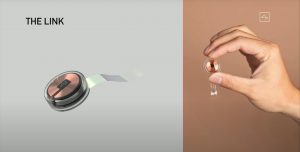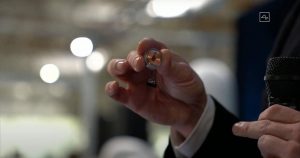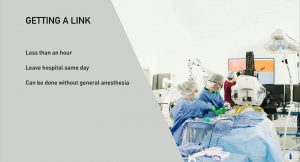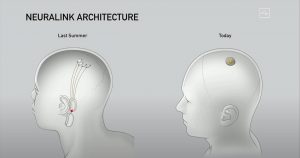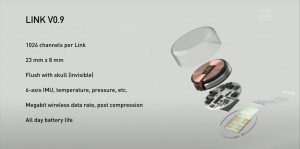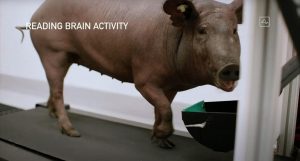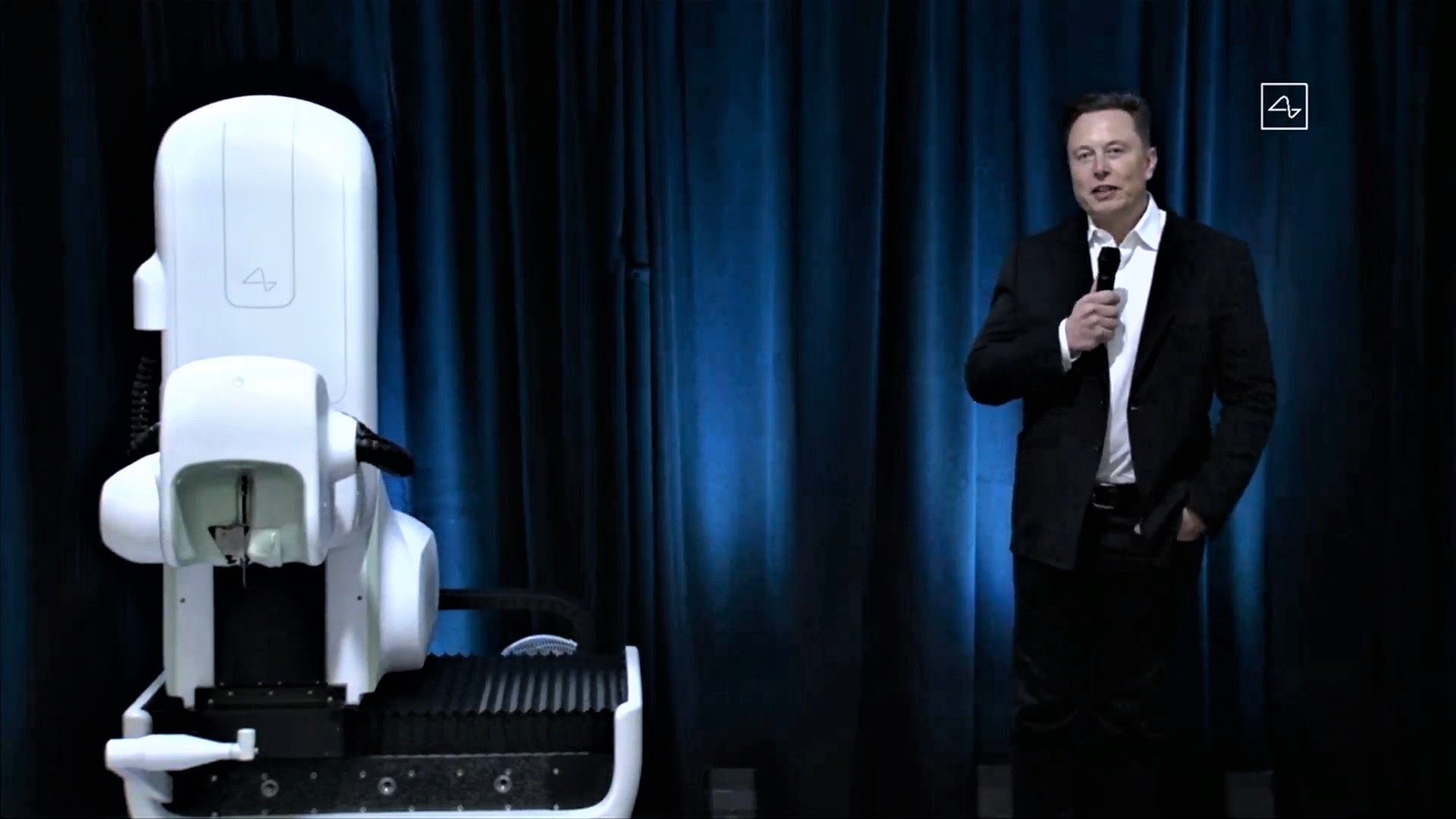
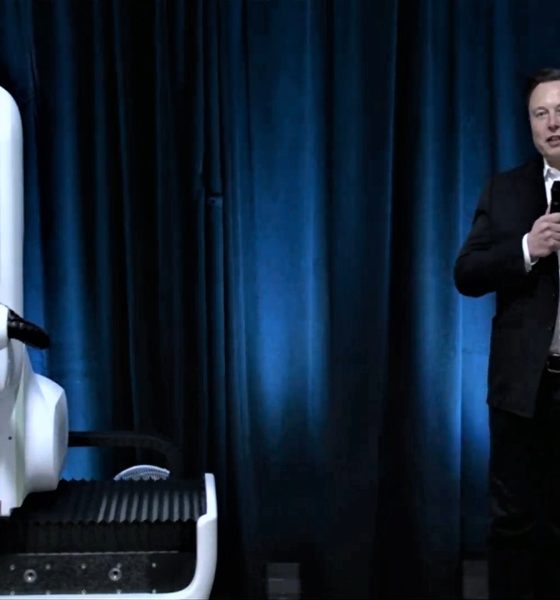
News
Elon Musk’s Neuralink unveils sleek V0.9 device, uses sassy pigs for live brain machine demo
After another year of successfully staying in the shadows, Elon Musk’s Neuralink has revealed what’s been going on behind the scenes in terms of technological progress. In a live streamed event on Friday afternoon, the brain-machine interface company gave a demonstration, took questions, and left audiences with even more to mull over than ever.
“The primary purpose of this demo is recruiting,” Musk stated at the very beginning of the presentation. He emphasized that everyone at some point in their life will face a brain or spine problem – all inherently electrical – meaning it takes electrical solutions to solve electrical problems. Neuralink’s goals are to solve these problems for anyone who wants them solved, and that application will be simple and reversible with no negative effects.
Two pigs were used for the ‘real-time’ demonstration promised in the days leading up to the event. The first, named Gertrude, had a Neuralink implant installed for two months and was shown to be healthy and happy. A second pig, named Dorothy, had the implant previously installed and removed with no side effects afterward.
- Elon Musk shows off the Neuralink v0.9 Device (Credit: Neuralink)
After a bit of a delay from the amusingly sassy Neuralink-implanted pigs, the live stream and in-house audience witnessed Gertrude’s device in action. Notably, the neural implants could predict all the limb movements of the pigs based on the neural activity being read. Each reading was shown on a screen and musical notes attached as the data was processed.
Overall, here are some of the main takeaways from the presentation.
- The Neuralink implant device has been dramatically simplified since Summer 2019. Its design will be very low profile and nearly invisible on the outside, leaving only a small scar that could be covered by hair. “It’s like a FitBit in your skull with tiny wires,” Musk half-joked. “I could have it right now and you wouldn’t even know. Maybe I do!”
- The implant device is inductively charged, much like wireless smartphones are charged. It will also have functions that are akin to those available on smartwatches today.
- A “smart” robot installs the device, which requires engineering talent to accomplish, hence the recruiting focus of the Neuralink event. The “V2” robot featured in this year’s presentation looks like a step up from last year’s machine.
- The electrodes are installed without general anesthesia, no bleeding, and no noticeable damage. The currently developed robot has done all the current implant installations to date.
- The implant can be installed and removed without any side effects.
- You can have multiple Neuralink devices implanted and they will work seamlessly.
- The implant device would have an application linked to your phones.
- Neuralink received a ‘breakthrough device’ designation from the FDA in July, and the company is working with the agency to make the technology as safe as possible.
- The device will eventually be able to be sewn deeper within the brain, thereby having access to a greater range of functions beyond the upper cortex. Examples are motor function, depression, and addiction.
- Getting a Neuralink should take less than an hour, without the need for general anesthesia. Users could have the surgery done in the morning and go home later during the day.
- Credit: Neuralink
- Credit: Neuralink
The idea for Musk’s AI-focused brain venture first seemed to really take off after his appearance at Vox Media’s Recode Code Conference in 2016. The CEO had discussed the concept of a neural lace device on several occasions up to that point and suggested at the conference that he might be willing to tackle the challenge himself. A few months later, he revealed that he was in fact working on the idea, which was detailed at great length by Tim Urban on his website Wait But Why.
“He started Neuralink to accelerate our pace into the Wizard Era—into a world where he says that ‘everyone who wants to have this AI extension of themselves could have one, so there would be billions of individual human-AI symbiotes who, collectively, make decisions about the future.’ A world where AI really could be of the people, by the people, for the people,” Urban summarized. Given that bigger picture perspective, the 2020 Neuralink event seems even more impactful.
Neuralink’s official Twitter account opened the virtual floor to questions using the #askneuralink hashtag the night before the event, prompting several questions during the presentation. However, Musk fanned the building curiosity in the hours beforehand. “Giant gap between experimental medical device for use only in patients with extreme medical problems & widespread consumer use. This is way harder than making a small number of prototypes,” Musk responded to one question directed towards the mass market viability of a future Neuralink product line.
https://twitter.com/flcnhvy/status/1299422178329362437
Also in the days prior to the Neuralink event, Musk teased a few more bits of information about what to expect. “Live webcast of working @Neuralink device,” he said. Just prior to his confirmation of the device demonstration, he revealed that version two of the robot initially shown in the first progress update in 2019 wasn’t quite up to the level of a LASIK eye surgery machine, though only a few years away.
You can watch the full event below:

News
Elon Musk’s Grokipedia surges to 5.6M articles, almost 79% of English Wikipedia
The explosive growth marks a major milestone for the AI-powered online encyclopedia, which was launched by Elon Musk’s xAI just months ago.

Elon Musk’s Grokipedia has grown to an impressive 5,615,201 articles as of today, closing in on 79% of the English Wikipedia’s current total of 7,119,376 articles.
The explosive growth marks a major milestone for the AI-powered online encyclopedia, which was launched by Elon Musk’s xAI just months ago. Needless to say, it would only be a matter of time before Grokipedia exceeds English Wikipedia in sheer volume.
Grokipedia’s rapid growth
xAI’s vision for Grokipedia emphasizes neutrality, while Grok’s reasoning capabilities allow for fast drafting and fact-checking. When Elon Musk announced the initiative in late September 2025, he noted that Grokipedia would be an improvement to Wikipedia because it would be designed to avoid bias.
At the time, Musk noted that Grokipedia “is a necessary step towards the xAI goal of understanding the Universe.”
Grokipedia was launched in late October, and while xAI was careful to list it only as Version 0.1 at the time, the online encyclopedia immediately earned praise. Wikipedia co-founder Larry Sanger highlighted the project’s innovative approach, noting how it leverages AI to fill knowledge gaps and enable rapid updates. Netizens also observed how Grokipedia tends to present articles in a more objective manner compared to Wikipedia, which is edited by humans.
Elon Musk’s ambitious plans
With 5,615,201 total articles, Grokipedia has now grown to almost 79% of English Wikipedia’s article base. This is incredibly quick, though Grokipedia remains text-only for now. xAI, for its part, has now updated the online encyclopedia’s iteration to v0.2.
Elon Musk has shared bold ideas for Grokipedia, including sending a record of the entire knowledge base to space as part of xAI’s mission to preserve and expand human understanding. At some point, Musk stated that Grokipedia will be renamed to Encyclopedia Galactica, and it will be sent to the cosmos.
“When Grokipedia is good enough (long way to go), we will change the name to Encyclopedia Galactica. It will be an open source distillation of all knowledge, including audio, images and video. Join xAI to help build the sci-fi version of the Library of Alexandria!” Musk wrote, adding in a later post that “Copies will be etched in stone and sent to the Moon, Mars and beyond. This time, it will not be lost.”
News
Tesla Model 3 becomes Netherlands’ best-selling used EV in 2025
More than one in ten second-hand electric cars sold in the country last year was a Tesla Model 3.

The Tesla Model 3 became the most popular used electric car in the Netherlands in 2025, cementing its dominance well beyond the country’s new-car market.
After years at the top of Dutch EV sales charts, the Model 3 now leads the country’s second-hand EV market by a wide margin, as record used-car purchases pushed electric vehicles further into the mainstream.
Model 3 takes a commanding lead
The Netherlands recorded more than 2.1 million used car sales last year, the highest level on record. Of those, roughly 4.8%, or about 102,000 vehicles, were electric. Within that growing segment, the Tesla Model 3 stood far ahead of its competitors.
In 2025 alone, 11,338 used Model 3s changed hands, giving the car an 11.1% share of the country’s entire used EV market. That means more than one in ten second-hand electric cars sold in the country last year was a Tesla Model 3, Auto Week Netherlands reported. The scale of its lead is striking: the gap between the Model 3 and the second-place finisher, the Volkswagen ID3, is more than 6,700 vehicles.
Rivals trail as residual values shape rankings
The Volkswagen ID.3 ranked a distant second, with 4,595 used units sold and a 4.5% market share. Close behind was the Audi e-tron, which placed third with 4,236 registrations. As noted by Auto Week Netherlands, relatively low residual values likely boosted the e-tron’s appeal in the used market, despite its higher original price.
Other strong performers included the Kia Niro, the Tesla Model Y, and the Hyundai Kona, highlighting continued demand for compact and midsize electric vehicles with proven range and reliability. No other model, however, came close to matching the Model 3’s scale or market presence.
News
Tesla Model Y Standard Long Range RWD launches in Europe
The update was announced by Tesla Europe & Middle East in a post on its official social media account on X.

Tesla has expanded the Model Y lineup in Europe with the introduction of the Standard Long Range RWD variant, which offers an impressive 657 km of WLTP range.
The update was announced by Tesla Europe & Middle East in a post on its official social media account on X.
Model Y Standard Long Range RWD Details
Tesla Europe & Middle East highlighted some of the Model Y Standard Long Range RWD’s most notable specs, from its 657 km of WLTP range to its 2,118 liters of cargo volume. More importantly, Tesla also noted that the newly released variant only consumes 12.7 kWh per 100 km, making it the most efficient Model Y to date.
The Model Y Standard provides a lower entry point for consumers who wish to enter the Tesla ecosystem at the lowest possible price. While the Model 3 Standard is still more affordable, some consumers might prefer the Model Y Standard due to its larger size and crossover form factor. The fact that the Model Y Standard is equipped with Tesla’s AI4 computer also makes it ready for FSD’s eventual rollout to the region.
Top Gear’s Model Y Standard review
Top Gear‘s recent review of the Tesla Model Y Standard highlighted some of the vehicle’s most notable features, such as its impressive real-world range, stellar infotainment system, and spacious interior. As per the publication, the Model Y Standard still retains a lot of what makes Tesla’s vehicles well-rounded, even if it’s been equipped with a simplified interior.
Top Gear compared the Model Y Standard to its rivals in the same segment. “The introduction of the Standard trim brings the Model Y in line with the entry price of most of its closest competition. In fact, it’s actually cheaper than a Peugeot e-3008 and costs £5k less than an entry-level Audi Q4 e-tron. It also makes the Ford Mustang Mach-E look a little short with its higher entry price and worse range,” the publication wrote.
